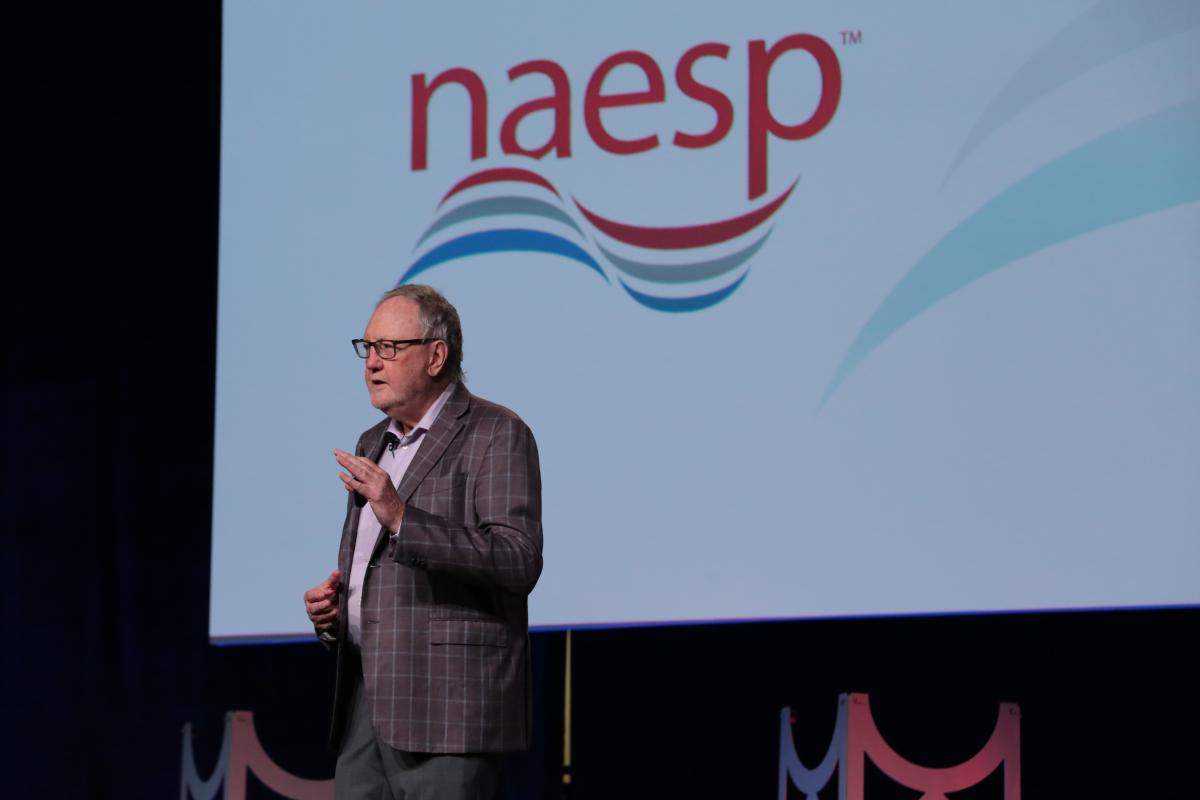A Unity of Purpose and Action
Michael Fullan explains why and how educators should set up students to do well in school and in life.
Michael Fullan explains why and how educators should set up students to do well in school and in life.
By Matt Scott
Communicator
July 2019, Volume 42, Issue 11
Michael Fullan addressing attendees at NAESP’s annual conference. Photo courtesy of Lifetouch®.
During the Pre-K–8 Principals Conference in Spokane, Washington, keynote speaker Michael Fullan highlighted his latest research on deep learning and revealed an inspiring message on how students and teachers respond best if they are focusing on global competencies. Fullan engaged, motivated, and challenged school administrators from across the country to lead students in finding their purpose in life by becoming nuanced leaders.
Overcoming Boredom in Schools
Fullan delivered information to school administrators that shed light on the current state of global education. It wasn’t promising: “Today’s students are bored,” he said. He also noted that inequity in our world is widening, and society is giving schools a bad deal. “The world is troubled, and even 10-year-olds know it.”
But Fullan gave us hope with his research on deep learning innovations: Goodness can evolve but only when special conditions are met, and as a human race, we can help create and meet those conditions when we have unity.
Finding a Purpose in Life
Fullan also challenged us to help students define and find their life purpose by leading and guiding them to see themselves as people who can contribute to bettering our world. Research shows that only 24 percent of high school students are pursuing a purpose for their life. Many focus on just getting good grades as a pathway to college and a career.
In today’s world, that’s not good enough. Students need to be good at learning and at life, said Fullan. His recommendation? Change our students with the following phrase: “Engage the world, change the world.”
New Types of Learning
Fullan explained the types of learning we should be transitioning to so we can be the change agents in our schools. It should be “irresistibly engaging, elegantly efficient, technologically ubiquitous, steeped in real-life problem-solving, and involve deep learning—quality learning that sticks with you the rest of your life and learning that engages the world and changes the world.”
Fullan’s book Deep Learning: Engage the World Change the World breaks down deep learning into the process of acquiring six global competencies, known as the six C’s: character, citizenship, collaboration, communication, creativity, and critical thinking.
These competencies encompass compassion, empathy, social-emotional learning, entrepreneurialism, and other related skills to becoming successful in our complex world. Fullan warned, “We will fail to spark the passion of our students if we are not teaching the six C’s.”
Takeaways
To maximize the impact of deep learning on students, Fullan encouraged us to create a shared ownership with teachers and reminded us that successful change processes are a function of shaping and reshaping good ideas as they build capacity. This process comes through the creation of collaborative structures, which must be nourished through teacher learning and development.
According to Fullan, the No. 1 influencer in student achievement was collective teacher efficacy. A successful collective efficacy among teachers can be created in an environment that provides frequent and specific collaboration. He calls it professional collaboration with purpose.
Finally, Fullan redefines the moral imperative as “raising the bar and closing the gap in both learning/academic achievement and in doing well in life.” To close the learning/achievement gap in schools and set up students also do well in life, we, as school administrators, must self-reflect and decide whether we are what he Fullan calls “surfacers or nuancers.” Surfacers treat problems as technical by concentrating on steps to the solutions, whereas nuancers work with key principles that lead to adjustable actions, which involves concepts and practical skills that require deep reflective actions.
Nuanced leaders are curious, humble, loyal to a better future, proud to celebrate success, open, and courageously and relentlessly committed to changing the system for the betterment of humanity, said Fullan. They’re able to connect to people, look below the surface, and change people’s emotions instead of their minds.
Fullan ended his keynote by encouraging us to be leaders who lead, listen, learn, and ask questions. He also encouraged us to model and mentor leadership in others so we could create a collaborative culture in our school to the point we become dispensable. Fullan stated there could be no progress without a unity of purpose and action that involved a sense of collective purpose to make improvements. As nuanced leaders, we can “engage the world and change the world.”
Matt Scott is principal at Creekside Primary in Harvest, Alabama.
—
Copyright © 2019. National Association of Elementary School Principals. No part of the articles in NAESP magazines, newsletters, or website may be reproduced in any medium without the permission of the National Association of Elementary School Principals. For more information, view NAESP’s reprint policy.


